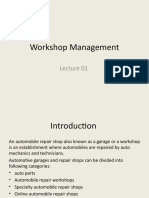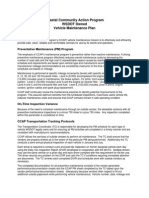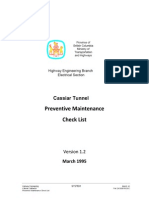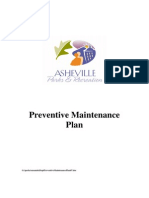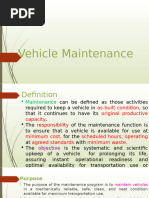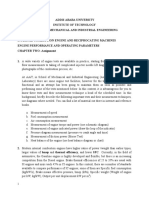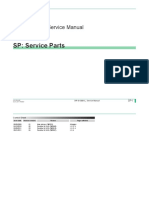83%(6)83% found this document useful (6 votes)
385 viewsAutomotive Maintenance: Course No.: Meng 5471
Automotive Maintenance: Course No.: Meng 5471
Uploaded by
Mc AxThis document discusses preventive maintenance programs and cycles for vehicle fleets. It covers:
1) Definitions of preventive and breakdown maintenance and how condition-based maintenance strives to identify faults before failures.
2) How failure rates follow a "bathtub curve" and the importance of maintenance in extending the useful life period.
3) Components of a preventive maintenance program including maintenance tasks, time/mileage intervals, and key personnel. Advantages include lower costs, increased safety and efficiency.
4) Development of maintenance checklists including consulting manufacturer recommendations and operating conditions to establish preventive maintenance codes.
Copyright:
© All Rights Reserved
Available Formats
Download as PPTX, PDF, TXT or read online from Scribd
Automotive Maintenance: Course No.: Meng 5471
Automotive Maintenance: Course No.: Meng 5471
Uploaded by
Mc Ax83%(6)83% found this document useful (6 votes)
385 views44 pagesThis document discusses preventive maintenance programs and cycles for vehicle fleets. It covers:
1) Definitions of preventive and breakdown maintenance and how condition-based maintenance strives to identify faults before failures.
2) How failure rates follow a "bathtub curve" and the importance of maintenance in extending the useful life period.
3) Components of a preventive maintenance program including maintenance tasks, time/mileage intervals, and key personnel. Advantages include lower costs, increased safety and efficiency.
4) Development of maintenance checklists including consulting manufacturer recommendations and operating conditions to establish preventive maintenance codes.
Original Description:
preventive maintenance program and cycle
Original Title
1_AUTOMOTIVE_MAINTENANCE_preventive_maintenance_program_and_cycle
Copyright
© © All Rights Reserved
Available Formats
PPTX, PDF, TXT or read online from Scribd
Share this document
Did you find this document useful?
Is this content inappropriate?
This document discusses preventive maintenance programs and cycles for vehicle fleets. It covers:
1) Definitions of preventive and breakdown maintenance and how condition-based maintenance strives to identify faults before failures.
2) How failure rates follow a "bathtub curve" and the importance of maintenance in extending the useful life period.
3) Components of a preventive maintenance program including maintenance tasks, time/mileage intervals, and key personnel. Advantages include lower costs, increased safety and efficiency.
4) Development of maintenance checklists including consulting manufacturer recommendations and operating conditions to establish preventive maintenance codes.
Copyright:
© All Rights Reserved
Available Formats
Download as PPTX, PDF, TXT or read online from Scribd
Download as pptx, pdf, or txt
83%(6)83% found this document useful (6 votes)
385 views44 pagesAutomotive Maintenance: Course No.: Meng 5471
Automotive Maintenance: Course No.: Meng 5471
Uploaded by
Mc AxThis document discusses preventive maintenance programs and cycles for vehicle fleets. It covers:
1) Definitions of preventive and breakdown maintenance and how condition-based maintenance strives to identify faults before failures.
2) How failure rates follow a "bathtub curve" and the importance of maintenance in extending the useful life period.
3) Components of a preventive maintenance program including maintenance tasks, time/mileage intervals, and key personnel. Advantages include lower costs, increased safety and efficiency.
4) Development of maintenance checklists including consulting manufacturer recommendations and operating conditions to establish preventive maintenance codes.
Copyright:
© All Rights Reserved
Available Formats
Download as PPTX, PDF, TXT or read online from Scribd
Download as pptx, pdf, or txt
You are on page 1of 44
Automotive Maintenance
(Preventive maintenance program and cycle)
Course No.: Meng 5471
COURSE CONTENTS
• Preventive maintenance program and
cycle
• Fleet Management Software study
• Condition monitoring instruments and
equipment;
• Vehicle troubleshooting and OBD
• Practice on inspection and adjustment of
vehicle
Definition
• Maintenance is any activity – such as tests, measurements,
replacements, adjustments and repairs — intended to retain or
restore a functional unit in or to a specified state in which the unit
can perform its required functions.
• Generally speaking, there are two types of maintenance in use:
– Preventive maintenance, where equipment is maintained before
break down occurs. This type of maintenance has many different
variations and is subject of various researches to determine best
and most efficient way to maintain equipment.
– Breakdown maintenance, where equipment is maintained after
break down. This maintenance is often most expensive because
worn equipment can damage other parts and cause multiple
damage.
– Condition based maintenance or predictive maintenance, is a
technology that strives to identify incipient faults before they
become critical which enables more accurate planning of the
preventive maintenance.
Maintenance and failure rate
• The need for maintenance is predicated on actual or
impending failure – ideally, maintenance is performed to
keep equipment and systems running efficiently for at
least design life of the component(s).
• As such, the practical operation of a component is time-
based function.
• If one were to graph the failure rate a component
population versus time, it is likely the graph would take
the “bathtub” shape shown in the following figure .
• In the figure the Y axis represents the failure rate and the
X axis is time.
Maintenance and failure rate
• From its shape, the curve can be divided into three
distinct: infant mortality, useful life, and wear-out periods.
• The initial infant mortality period of bathtub curve is
characterized by high failure rate followed by a period of
decreasing failure. Many of the failures associated with
this region are linked to poor design, poor installation, or
misapplication.
Maintenance and failure rate
• The infant mortality period is followed by a nearly
constant failure rate period known as useful life. There
are many theories on why components fail in this region,
most acknowledge that poor Operation and Maintenance
often plays significant role.
• It is also generally agreed that exceptional maintenance
practices encompassing preventive and predictive
elements can extend this period.
Maintenance and failure rate
• The wear-out period is characterized by a rapid
increasing failure rate with time. In most cases this
period encompasses the normal distribution of design life
failures.
Maintenance and failure rate
• The design life of most equipment requires periodic
maintenance. Belts need adjustment, alignment needs to
be maintained, proper lubrication on rotating equipment
is required, and so on.
• In some cases, certain components need replacement,
(e.g., a wheel bearing) to ensure the main piece of
equipment (in this case a car) last for its design life.
• Anytime we fail to perform maintenance activities
intended by the equipment’s designer, we shorten the
operating life of the equipment.
Preventive maintenance
• Planned preventive maintenance is regular, repetitive work
done to keep the vehicle in good working order and to
optimize its efficiency and accuracy.
• This activity involves regular, routine cleaning, lubricating,
testing, calibrating and adjusting, checking for wear and tear
and eventually replacing components to avoid breakdown.
• Productive preventive maintenance refers to the proper
selection of vehicle to be included in planned preventive
maintenance.
• Decisions must be made on what to include to reduce costs;
inexpensive units that are not necessarily included in the
planned preventive maintenance program can be replaced or
repaired when they break down.
• The overriding consideration is safety and cost effectiveness.
Preventive maintenance
• Preventive maintenance is a necessary expense
to keep your vehicle in good running condition.
• Following the scheduled maintenance
recommendations in your owner's manual,
checking fluid levels regularly and changing the
fluids and filters periodically can minimize the
risks of breakdowns and prolong the life of
the engine, transmission, cooling system, brakes
etc.
• So if you have a "maintenance challenged"
vehicle in your fleet, you need to pay closer
attention to your fluids and filters.
Preventive maintenance
• Setting up a planned preventive maintenance
system
– In order to establish an effective, efficient planned
preventive maintenance system, a registry filing
system is needed.
– The manufacturer's manual for preventive
maintenance of the vehicle can be supplemented by
computer packages in setting up such a system; if a
computer is not available, a manual file can be set up.
Preventive maintenance
The planned preventive maintenance administrative system
requires the following:
• Vehicle Needs Determination
– Maintenance begins with choosing the appropriate vehicle to do
the required job.
– Fleet Managers must analyze their transportation needs in terms
of organization mission (s) and the work that must be done.
Improper vehicle specifications will result in higher maintenance
and repair costs.
• A vehicle that offers more than needed to do a job (over-specified) costs
more initially and will most likely result in higher operating costs.
• If a vehicle is inadequately equipped or powered (under-specified), expect
shorter life, more breakdowns, and a higher overall maintenance cost.
• Standardization in vehicle selection
– For fleets that handle maintenance in-house, standardization in
vehicle selection (and added features and capabilities) means
reduced parts inventory, enhanced ability of mechanics to repair
vehicles efficiently and dependably, and a better measure of the
suitability of equipment for assigned tasks over time.
Preventive maintenance
• Objectives of a Fleet preventive Maintenance Program
– To maximize the useful life and reliability of vehicles while
minimizing total life cycle costs.
– To assure that PM work is scheduled at appropriate
intervals.
– To assure that PM work is performed in compliance with
schedules.
– To perform appropriate PM tasks according to vehicle
requirements.
– To complete PM work in a timely manner to minimize
downtime and customer inconvenience.
– To ensure all warranties and guarantees are honored.
– To minimize the cost of maintenance to the organization.
Preventive maintenance
• What kind of maintenance programs must we have?
• We must have a preventive (scheduled) maintenance
program for each motor vehicle.
• The scheduled maintenance program must:
– Meet all emission standards;
– Meet manufacturer warranty requirements;
– Ensure the safe and economical operating condition
of the motor vehicle throughout its life; and
– Ensure that inspections and servicing occur as
recommended by the manufacturer or more often if
local operating conditions require.
Advantages of preventive maintenance
– Detecting and correcting deficiencies in any of a vehicle’s
systems in their early stages, before they develop into major
defects, results in lower maintenance costs.
– Executing a planned repair in a shop is more cost-effective than
fixing a breakdown.
– Equipment breakdowns and downtime can be significant costs.
Downtime results in decreased efficiency of the organization,
loss of productivity and poor customer relations.
– Safety related defects identified before use can avoid accident,
injury and death.
– preventive maintenance helps ensure that all motor vehicles are
maintained and serviced according to the vehicle manufacturer's
recommendations and hence meet warranty requirements
– preventive maintenance helps ensure that all motor vehicles
meet emissions standards and are energy efficient
Components of preventive
Maintenance Program
• A PM program has three major components:
– Maintenance tasks that need to be performed
periodically.
– Time/mileage intervals for the performance of
these tasks.
– Key personnel involved to include the driver, the
mechanic (s) performing the work and the Fleet
Manager.
Development of the Maintenance Task and
Time/Mileage Interval Checklist
• To develop effective vehicle-specific, scheduled
maintenance or PM requirements, Fleet
Managers will:
– consult the manufacturer's recommended
maintenance standards,
– understand the operating conditions of the vehicle,
and
– study reports of past experiences with the specific
vehicle/vehicle class and the history of unscheduled
maintenance on the vehicle or class.
Detailed record keeping will allow a Fleet Manager to
identify emergency repairs and separate these repairs
from other unscheduled maintenance items.
Development of the Maintenance Task and
Time/Mileage Interval Checklist
• Typically, a Fleet Manager will set up PM codes. Each PM code is
the key to a set of rules that spell out what needs to be done and
when for each type of vehicle in the fleet.
• Because of similarities among various classes of fleet vehicle,
creation of a code for each vehicle in the fleet is unnecessary.
• Maintenance managers typically refer to manufacturer guidelines
and their own experience and working conditions to design a PM
program and define the codes.
• For example, passenger car manufacturers typically publish
maintenance requirements for “normal” and “severe” service
conditions. The oil change interval for normal service could be
7,500 miles while the interval for severe service is 3,000. The
maintenance manager might even use a mid-range interval, such as
5,000 miles, in some applications.
Development of the Maintenance Task and
Time/Mileage Interval Checklist
• Most fleets operate under what is considered severe
duty, including:
– Towing a trailer or using a camper or car-top
carrier.
– Extensive idling and/or low-speed driving (such as
inner-city driving or stop-and-go traffic).
– Vehicles used for commercial applications such as
deliveries, taxi, livery, or patrol car.
– Vehicles used by multiple drivers such as fleet or
motor pool operations.
– Vehicles operated in off-road or dusty conditions.
Development of the Maintenance Task and
Time/Mileage Interval Checklist
• The PM task list itself is designed to address vehicle needs at each
interval. Many fleets use “PM echelons” to identify different sets of
tasks to be performed at different intervals for each class of vehicle.
These echelons are fairly standard in the industry:
– PM-A: inspection and light maintenance procedure that is
essentially an oil change, lubrication, filters as necessary, and
safety inspection of lights, brakes, etc. PM-A is usually
synonymous with the most frequent interval.
– PM-B: a more thorough list of tasks but would include all tasks in
the “A” level PM, typically performed every 2nd or 3rd scheduled
PM.
– PM-C: if needed, addresses long-interval procedures such as a
transmission flush, cooling system flush, etc.
• For heavy vehicles, even more PM echelons might be necessary.
Refer to manufacturer’s recommendations for details.
Development of the Maintenance Task and
Time/Mileage Interval Checklist
• To simplify program management, make your
PM intervals mathematically consistent (for
example, if the PM-A interval is 5,000 miles, then
all other intervals should be multiples of 5,000
[that is, PM-B = 15,000 miles; PM-C interval =
30,000 miles]).
• Specific tasks should reflect the specific needs
of the vehicle (for example, diesels don’t need
spark plugs, so the task list for their “tune up”
wouldn’t show spark plugs).
Development of the Maintenance Task and
Time/Mileage Interval Checklist
• Sample PM Coding Table
PM Code PM Interval
001 3,000 miles or 6 months
002 5,000 miles or 6 months
003 7,000 miles or 6 months
004
005
011 25 hours or 6 months
012 50 hours or 6 months
013 100 hours or 6 months
014 200 hours or 6 months
015 300 hours or 6 months
016
017
021 30 days
022 61 days
023 91 days
024 121 days
025 182 days
026 365 days
Development of the Maintenance Task and
Time/Mileage Interval Checklist
• Based on the sample PM coding table shown
above, a typical vehicle such as a 4x4 pickup
truck might be assigned PM code 002 and would
have the following interval/task schedule (also
known as PM levels):
– PM – A: 5,000 miles or 6 months
– PM – B: 15,000 miles or 12 months
– PM – C: 30,000 miles or 24 months
– PM – D: 60,000 miles or 48 months
– PM – E: 90,000 miles or 60 months
Development of the Maintenance Task and
Time/Mileage Interval Checklist
• An example of a typical list of tasks to be
performed by interval at each level is
shown on the following table;
• However, the manufacturer’s
recommendations should always be
followed.
Interval Service Item Description
5000 Change engine oil & filter
Check all fluids & top off as needed
Check safety devices
Check/clean battery & battery terminals
Inspect belts & hoses
Inspect engine & transmission for leaks
Inspect exhaust & emission systems
Inspect fuel tank, cap & lines
Inspect undercarriage
Rotate tires
Test brakes
Test lights, horn & wipers for proper operation
15000 Inspect radiator
Lubricate hinges, latches, locks, slides & weatherstrips
Check spring u-bolt torque
Check/adjust headlights
Check/adjust parking brake
Inspect brake system
Inspect suspension & steering system
Lubricate transfer case shift lever pivot bolt & control rod connecting pins
30000 Change automatic transmission fluid & filter
Flush brake fluid
Inspect/lubricate manual hub locks
Inspect/lubricate spindle needle bearings
Inspect/service cooling system
Replace air filter
Replace differential oil
Replace fuel filter
Replace spark plugs
Development of the Maintenance Task and
Time/Mileage Interval Checklist
• The Fleet Manager must develop maintenance
schedules for his/her fleet and maintain proper
records for each vehicle.
• Schedules should include provisions for
appropriate safety and emissions inspections as
well as other PM tasks.
• Scheduled maintenance (as well as
unscheduled maintenance) should be
documented in the repair history of the vehicle.
Predictive Maintenance
• Another key to an effective PM program is to
know which vehicles are trouble-prone and
which are reliable. That knowledge can save a
fleet time, money, and grief.
• If a Fleet Manager can identify before-hand
those vehicles that are prone to certain
mechanical problems, he or she can:
– Cut the model from the selector list
– Dispose of the vehicle (s) before the end of their life
cycle; or
– Be prepared for the mechanical problems likely to
appear on these models or vehicle types.
Predictive Maintenance
• A fleet predictive maintenance program offers a means
for a Fleet Manager to schedule vehicle repairs before
components fail, and this is especially important for
vehicles with long replacement cycles.
• For example, if a Fleet Manager knows a component is
likely to fail or a system to malfunction at 60,000 miles or
5,000 hours, the component or system can be replaced
or serviced before that mileage or time limit has been
reached.
• A predictive maintenance program consists of three
basic steps:
– Collect vehicle repair data
– Analyze (collected data); and
– Correct, repair, or replace selected component (s).
Breakdown maintenance
• Maintenance performed on broken machines to restore
them to working order.
• Breakdown maintenance involves the repair or
replacement of machines and components after they
have failed.
• This kind of management strategy can be contrasted
with preventive and predictive maintenance, which are
designed to avoid machine failures.
• The breakdown maintenance approach is typically
employed when failures are unlikely to result in
workplace injuries or excessive downtime, though the
costs associated with emergency repairs are often
prohibitive.
Breakdown maintenance
• Unlike preventive approaches, breakdown maintenance
is a reactive policy.
• This approach avoids the costs associated with
inspections and preemptive repairs by simply allowing
components to fail and then addressing the issue after
the fact.
• The term "run-to-failure" is also used to describe this
approach to maintenance, since that is what equipment
is allowed to do.
• Equipment will typically be lubricated and receive other
minor attention under this kind of maintenance policy,
though that is usually the extent of any ongoing
maintenance operations.
Breakdown maintenance
• There are a number of costs that can be
associated with a breakdown maintenance
policy.
• Since any component can fail at any time under
this approach, a maintenance staff must be
ready to do many different types of repairs.
• This can involve maintaining a stock of
replacement parts for every piece of equipment
onsite, or else paying for rush shipping on new
components as the old ones fail.
Breakdown maintenance
• There are typically also costs associated with downtime,
so this approach to maintenance is not well-suited to any
business operation that would suffer large monetary
losses from the sudden failure of any given piece of
equipment.
• A policy of breakdown maintenance is sometimes
instituted when a facility or business has been scheduled
to close. This is often a calculated risk, since the
decision assumes that the equipment will continue
running long enough for the facility to be closed down.
• If there are plans to scrap the equipment at the end of
the period, costly preventive maintenance can be seen
as unnecessary.
Preventive maintenance planning
• The maintenance planning is critical to the success of
maintenance organization.
• Your maintenance effort will fail IF YOU DO NOT plan.
• There are several components to a good job plan—the order
in which you assemble these pieces is not nearly as important
as the fact that none of them are to be skipped.
• The various components of a complete job plan include:
– job steps;
– tool list;
– skills roster;
– bill of materials (BOM) and parts list;
– diagrams, photographs, illustrations;
– standard maintenance procedures (SMPs);
– Safety, including personal protective equipment
(PPE).
Preventive maintenance planning
• Job steps
– The recommendation is to begin by writing down the actual job
steps.
– The procedure should be written as a numbered list with each
number representing one of the finite steps of the job.
– The steps should be recorded in the order they are to occur.
– If the planner happens to be a former technician who has
performed the task before, then this portion of the process
should be pretty straightforward.
– If the planner has not performed the job before, he/she must
consult with someone who has.
– If the job being planned has not been performed by any current
employee, it is strongly recommended that you hire an outside
contractor not only help write the job plan, but assist in doing the
actual job as well.
Preventive maintenance planning
• Tool list
– Once the job steps have been written down in order
and checked for errors or omissions, the next step is
to analyze the job with an eye to constructing the tool
list.
– The tools referred to here are in addition to those that
we would normally expect to find in a workshop—they
are specific tools required to do the job.
– These items might include cranes, alignment and
measurement devices, specialty tools, power tools,
and a large variety of other things not needed for
every job.
– This is a critical step that must not be skipped by the
planner.
Preventive maintenance planning
• Skills roster
– The skills roster is, in many ways, similar to
the tool list.
– The difference is that while your tool list
specifies the exact tools that will be needed to
successfully complete a job, this roster is a list
of the skill sets that will be required to finish
the task.
– It's always better to list the skill sets that will
be needed to complete the project.
Preventive maintenance planning
• Bill of materials and parts list
– The bill of materials (BOM) and parts list is one of the most important
portions of the job plan.
– It represents, literally, the nuts and bolts of the job. As such, it should
be as specific as possible.
– Parts should be listed by both part number and description, and no
job plan should progress to the ready stage until every part is on
hand and has been verified to be the correct part.
– This specificity is not only important with regards to parts. Materials
such as , epoxy, oils, grease, nuts, bolts, washers, rubber hose, O-
rings and hundreds of other non-job-specific materials must be listed
on the job plan.
– When the job is scheduled, these materials must be verified as being
on-hand and available for use.
– In addition to being a complete record of all parts and materials, your
BoM and parts list should also indicate any special disposal
instructions for removed or replaced parts.
Preventive maintenance planning
• Diagrams, photographs and/or illustrations
– The planner literally cannot include too much illustrative material
with a job plan.
– A good planner should take advantage of the fact that we live in
a digital world and illustrate job plans accordingly.
– Even something as simple as a good color picture of the job site
with a circle drawn around the part to be replaced or repaired
can be a great help to a team of technicians unfamiliar with the
job.
– Each diagram, photo and/or illustration should be numbered or
lettered and referred to with that designation in the appropriate
written job step—as in "See Illustration #2" or "Refer to Diagram
A."
– Specific materials that come with parts should be handled in the
same manner, with copies of the instruction sheets being
included in the job packet while the original remains with the
part.
Preventive maintenance planning
• Standard maintenance procedures
– It's helpful to include copies of specific SMPs in the job plan if
those procedures are necessary to the successful completion of
the job.
– If you have confidence that your maintenance professionals are
performing in practice at the same level that they are on paper,
this step may not be necessary.
– But your planner should include the SMP if there is any doubt
that any member of your staff may find himself or herself out in
the field under the pressure of a deadline not knowing how to
perform a task.
– Remember that a job plan must be written with your least-skilled
technician in mind, because that is the person who might draw
the work.
– An SMP is, in reality, a small job plan, and it is designed to
impart information to those who need it.
(SAMPLE REPAIR MANUAL TOYOTA CARINA E)
Preventive maintenance planning
• Safety and personal protective equipment (PPE).
– After the rest of the job plan is written, the
planner has all of the necessary components to
be able to write the crucial safety portion of the
job plan.
– Once the scope of the work has been
determined, critical information such as ,what
PPE will be required and which safety protocols
must be observed can be determined.
Preventive maintenance planning
• After all components of the job plan have been
completed, it is time to put together the job
packet. The recommend order is:
– Safety
– Job Steps
– Tool List
– Skills Roster
– Bill of Materials (BoM) and Parts
– Diagrams, Photographs and/or Illustrations
– Standard Maintenance Procedures (SMPs)
Preventive maintenance planning
• Once the packet has been assembled, it should
be given to a technician who should then read
over the job plan with the following question in
mind: If I had to complete this job using only this
job plan as my guide, could I do it?
• The answer will determine whether or not the job
plan is complete.
• If any part of the plan is unclear, the time to
make the change is before the job begins.
Preventive maintenance planning of
vehicle fleet
• Once the maintenance planning for the vehicles is finalized, the next
step is to keep all the vehicles in the fleet in a schedule for
preventive maintenance.
• From the preventive maintenance planning of each vehicle the time
and manpower required for each service can be determined.
• From this the total time and manpower required can be determined
and compared with the available one.
• Based on the result of the comparison, each vehicle in the fleet will
be scheduled for preventive maintenance in consultation with the
logistic manager.
• Each vehicle driver will also be reminded ahead of time so that the
vehicle will be delivered for the scheduled preventive maintenance
on time.
• The data can also be used for skill gap identification and training
planning for the technicians.
(SAMPLE PREVENTIVE MAINTENANCE SERVICE SCHEDULE)
Parts and lubricant requirement
planning
• Once the maintenance planning is finalized, the
plan can be used to determine the parts and
lubricant requirements.
• From the maintenance plan of each vehicle, the
type and amount of parts and lubricants with
proper specification will be sorted out and
summed.
• This data can also be used for budgeting of
parts and lubricants.
You might also like
- Standard Operating Procedure: Vehicle MaintenanceDocument1 pageStandard Operating Procedure: Vehicle MaintenanceAdolfus100% (5)
- Fleet Management Manual 2020 - FINALDocument46 pagesFleet Management Manual 2020 - FINALMuhammad Rizqi Siregar100% (3)
- Automotive Workshop SafetyDocument44 pagesAutomotive Workshop Safetynewairley73% (11)
- DORC SOP For Operations StaffDocument7 pagesDORC SOP For Operations StaffChiemeka Osondu100% (1)
- Checklist For CarDocument4 pagesChecklist For Carsai sandip100% (1)
- Lecture 1. Workshop ManagementDocument44 pagesLecture 1. Workshop ManagementDerrick Maatla Moadi100% (1)
- CBLM Drive Light Vehicle Final CompressDocument64 pagesCBLM Drive Light Vehicle Final CompressRegie Dumaran Cuba100% (1)
- Vehicle Maintenance PlanDocument8 pagesVehicle Maintenance PlanLucho Dom100% (2)
- Vehicle Use Policy ManualDocument4 pagesVehicle Use Policy ManualBryce BihagNo ratings yet
- Preventive Maintenance and Inspection ProceduresDocument13 pagesPreventive Maintenance and Inspection ProceduresOsagie AlfredNo ratings yet
- Total Productive Maintenance For Organisational EffectivenessFrom EverandTotal Productive Maintenance For Organisational EffectivenessRating: 4 out of 5 stars4/5 (5)
- ISO 13849 PL Calculations SimplifiedDocument119 pagesISO 13849 PL Calculations SimplifiedAnonymous jW9BkgbQmE100% (1)
- What Are The Different Types of Maintenance Systems.?: Uncategorized Edit CategoriesDocument6 pagesWhat Are The Different Types of Maintenance Systems.?: Uncategorized Edit CategoriesArif Khan100% (1)
- Fleet Maintenance ProgramDocument6 pagesFleet Maintenance ProgramTariq Khan100% (1)
- What Is A Vehicle InspectionDocument3 pagesWhat Is A Vehicle InspectionFranz Martinez100% (2)
- Daily Check & MaintenanceDocument22 pagesDaily Check & MaintenancePMV DeptNo ratings yet
- Industrial Preventive MaintenanceDocument360 pagesIndustrial Preventive MaintenanceRonald Acbang100% (3)
- TR HEO (On Highway Dump Truck Rigid)Document74 pagesTR HEO (On Highway Dump Truck Rigid)Angee PotNo ratings yet
- Guideline For WorkshopDocument16 pagesGuideline For WorkshopZC47No ratings yet
- TR - Automotive Electrical Assembly NC IIIDocument76 pagesTR - Automotive Electrical Assembly NC IIIMichael V. MagallanoNo ratings yet
- Maintenance and Repair Cost Calculation ManualDocument8 pagesMaintenance and Repair Cost Calculation ManualShemels100% (2)
- Heavy Eq. Maintenance PlanDocument5 pagesHeavy Eq. Maintenance PlanHangga Dwi PerkasaNo ratings yet
- Sample Preventative Maintenance Inspection Sheet: Fixed Route Vehicle InspectionDocument4 pagesSample Preventative Maintenance Inspection Sheet: Fixed Route Vehicle InspectionVin BdsNo ratings yet
- Company Vehicle PolicyDocument16 pagesCompany Vehicle PolicyHR100% (1)
- Periodic MaintenanceDocument38 pagesPeriodic Maintenancedisq100% (24)
- Preventive Maintenance Check List: March 1995Document115 pagesPreventive Maintenance Check List: March 1995Vigilante Vg100% (2)
- Vehicle Wheel ServiceDocument12 pagesVehicle Wheel ServiceNadhirah JohaNo ratings yet
- Vehicle Inspection TrainingDocument32 pagesVehicle Inspection Trainingsourabh singh tomerNo ratings yet
- KPI of Maintenance Management in Beverage IndustryDocument8 pagesKPI of Maintenance Management in Beverage IndustryDon AndrianoNo ratings yet
- Sample Medium Maintenance PlanDocument20 pagesSample Medium Maintenance PlanPatrick PhoenixNo ratings yet
- Maintenance PhilosophiesDocument8 pagesMaintenance PhilosophiesZainNo ratings yet
- 6) Perform Underchassis Preventive MaintenanceDocument52 pages6) Perform Underchassis Preventive MaintenanceROSAN YUMANGNo ratings yet
- TR - Heavy Equipment Servicing NC IIDocument90 pagesTR - Heavy Equipment Servicing NC IIApple MonderinNo ratings yet
- Preventive Maintenance PlanDocument16 pagesPreventive Maintenance PlanAugust Hari0% (1)
- Light Vehicle Inspection ManualDocument409 pagesLight Vehicle Inspection ManualJavier Manrique50% (2)
- Unit 2 Worksheet: Automotive Tools and Their Uses: Automotive Mechanics 10e, Chapter 4Document8 pagesUnit 2 Worksheet: Automotive Tools and Their Uses: Automotive Mechanics 10e, Chapter 4ajay100% (1)
- Workshop Management Handbook PDFDocument76 pagesWorkshop Management Handbook PDFMukul Sharma100% (2)
- New Car PDIDocument3 pagesNew Car PDIsabarinath iyerNo ratings yet
- 3 Ok Workshop Housekeeping ScheduleDocument1 page3 Ok Workshop Housekeeping ScheduleCeloSakiNo ratings yet
- Shop Management ModuleDocument31 pagesShop Management ModuleEllen WaminalNo ratings yet
- Car Maintenance Schedule For 5,000-Mile Intervals Make: Model: YearDocument2 pagesCar Maintenance Schedule For 5,000-Mile Intervals Make: Model: YearНиколче Митриќевски100% (1)
- Stock Management and ControlDocument57 pagesStock Management and ControlACCOMMODATION CENTRENo ratings yet
- Daily Inspection Vehicle 6211099 01Document1 pageDaily Inspection Vehicle 6211099 01jinyuan74No ratings yet
- Types of MaintenanceDocument2 pagesTypes of MaintenanceHaris MunirNo ratings yet
- Section 5 - Maintenance Plan - Revised 2015 TrackDocument27 pagesSection 5 - Maintenance Plan - Revised 2015 TrackThunder PigNo ratings yet
- CAR Part 3Document47 pagesCAR Part 3Joseph Tiña FordNo ratings yet
- Unit I Maintenance of Records and SchedulesDocument19 pagesUnit I Maintenance of Records and Schedulespugal4No ratings yet
- Technical Support Specialist Automation 2019Document11 pagesTechnical Support Specialist Automation 2019luis angel jimenez briones100% (2)
- Maintenance ManagementDocument14 pagesMaintenance Managementtarun1133No ratings yet
- 70.14 Spare Parts Step4 - Define Policies For Stock Management - UnlockedDocument22 pages70.14 Spare Parts Step4 - Define Policies For Stock Management - UnlockedAsha Mathew100% (3)
- Fleet Checklist TRICYCLEDocument1 pageFleet Checklist TRICYCLEfavowritesNo ratings yet
- TR Heavy Equipment ServicingDocument95 pagesTR Heavy Equipment ServicingJuliusOuanoNo ratings yet
- Planned Maintainece System For ShipsDocument22 pagesPlanned Maintainece System For ShipsHarshad TallurNo ratings yet
- Predictive and Preventive MaintenanceDocument11 pagesPredictive and Preventive MaintenanceShyamNo ratings yet
- 2.maintenance EngineeringDocument26 pages2.maintenance EngineeringCharles Ondieki100% (1)
- chapter three dynamicDocument57 pageschapter three dynamicYohanis AgumaseNo ratings yet
- Maintlect 1Document33 pagesMaintlect 1Mohammed youssifNo ratings yet
- maintenenceDocument15 pagesmaintenencekuethabibullahNo ratings yet
- Chp. 7: Plant Maintenance: Faculty of Chemical Engineering Universiti Teknologi MARADocument26 pagesChp. 7: Plant Maintenance: Faculty of Chemical Engineering Universiti Teknologi MARASolehah OmarNo ratings yet
- UNIT.1: Maintenance, Maintenance Planning, & Maintenance Activity For Machine ToolsDocument51 pagesUNIT.1: Maintenance, Maintenance Planning, & Maintenance Activity For Machine Toolsjulakanti1No ratings yet
- Internship ReportDocument36 pagesInternship ReportMc AxNo ratings yet
- Carburetor Fuel System: By: Abel AbebeDocument167 pagesCarburetor Fuel System: By: Abel AbebeMc AxNo ratings yet
- Thermoelectric Generator: Concept NoteDocument4 pagesThermoelectric Generator: Concept NoteMc AxNo ratings yet
- CH03 Power Plant Part 2Document31 pagesCH03 Power Plant Part 2Mc AxNo ratings yet
- 3 AUTOMOTIVE MAINTENANCE Vehicle Troubleshooting REVISEDDocument16 pages3 AUTOMOTIVE MAINTENANCE Vehicle Troubleshooting REVISEDMc AxNo ratings yet
- 2.governing Eqns of Potential FlowDocument30 pages2.governing Eqns of Potential FlowMc AxNo ratings yet
- Assignment 1Document1 pageAssignment 1Mc AxNo ratings yet
- Chapter 3 - ExercisesDocument2 pagesChapter 3 - ExercisesMc AxNo ratings yet
- 3.two Dimensional Potential Flow Theory - ContunedDocument66 pages3.two Dimensional Potential Flow Theory - ContunedMc AxNo ratings yet
- Chapter 2 - ExercisesDocument4 pagesChapter 2 - ExercisesMc AxNo ratings yet
- Guide To Finding and Using Reliability Data For QRA: Source ResponsibleDocument42 pagesGuide To Finding and Using Reliability Data For QRA: Source Responsibleeng.tomasoniNo ratings yet
- The University of Alabama in Huntsville ECE Department CPE 628 01 Test 1 Solution Fall 2008Document4 pagesThe University of Alabama in Huntsville ECE Department CPE 628 01 Test 1 Solution Fall 2008mohan sardarNo ratings yet
- FadecDocument6 pagesFadecMarina IlicNo ratings yet
- Reliability BookDocument125 pagesReliability BookCHINEDU CHIEJINENo ratings yet
- W3a Reliability, MTTF, Availability, RedundancyDocument67 pagesW3a Reliability, MTTF, Availability, RedundancyShahid Shaja100% (1)
- Dsss TelDocument5 pagesDsss Telmandar.linkedinNo ratings yet
- Implementation of Norsdok z008 1685528Document7 pagesImplementation of Norsdok z008 1685528Tanjim RahmanNo ratings yet
- Análisis de SupervivenciaDocument441 pagesAnálisis de Supervivenciamelimeli106100% (1)
- 01 Workshop Predictive Maintenance 2022 - Maintenance ManagementDocument55 pages01 Workshop Predictive Maintenance 2022 - Maintenance ManagementZaky DriveNo ratings yet
- 300CL EspDocument8 pages300CL EspClaudiaNo ratings yet
- Ken Deil 2019Document167 pagesKen Deil 2019oscarNo ratings yet
- MAE342 Lecture 24Document27 pagesMAE342 Lecture 24marian goleaNo ratings yet
- A Reliability Analysis and Comparison of BatteryDocument5 pagesA Reliability Analysis and Comparison of BatteryNkululeko Blessing NdovelaNo ratings yet
- Reliability Engineering For Medical DevicesDocument41 pagesReliability Engineering For Medical DevicesRavish BangreNo ratings yet
- Logistics in The Bio Pharmaceutical Industry PublishedDocument4 pagesLogistics in The Bio Pharmaceutical Industry PublishedMartin PeacockNo ratings yet
- Statistics For Engineers Lecture 4 Reliability and Lifetime DistributionsDocument21 pagesStatistics For Engineers Lecture 4 Reliability and Lifetime Distributionsradha gulatiNo ratings yet
- MN5554 Reliability NotesDocument64 pagesMN5554 Reliability NotesAswin P SubhashNo ratings yet
- Risk Analysis TDA VDocument4 pagesRisk Analysis TDA VKAG salesNo ratings yet
- Troubleshooting Electronic Equipment - Nodrm PDFDocument563 pagesTroubleshooting Electronic Equipment - Nodrm PDFhanshyam86% (7)
- Performance of Simple Response Method For The Establishment and Adjustment of Calibration IntervalsDocument6 pagesPerformance of Simple Response Method For The Establishment and Adjustment of Calibration IntervalsAriana Lucia Rocha MendezNo ratings yet
- Reliability Calculation Methodologies For Mechanisms and ActuatorsDocument10 pagesReliability Calculation Methodologies For Mechanisms and ActuatorsAbdel ChawkiNo ratings yet
- 57e4d64a5ae56 1317890 SampleDocument32 pages57e4d64a5ae56 1317890 Samplemanaswini sharma B.G.100% (3)
- MIL-HDBK-217F N2 Parts Count AnalysisDocument13 pagesMIL-HDBK-217F N2 Parts Count AnalysisAna MarksNo ratings yet
- Brakes and Clutches: 12.0 Table of ContentsDocument22 pagesBrakes and Clutches: 12.0 Table of ContentsNoel GideonNo ratings yet
- CH 4Document34 pagesCH 4mwasdave153261No ratings yet
- Appendix E: Electrical Reliability ExampleDocument12 pagesAppendix E: Electrical Reliability ExampleAlexandre GelsiNo ratings yet
- Teaching Distribution System Reliability Evaluation Using Monte Carlo SimulationDocument7 pagesTeaching Distribution System Reliability Evaluation Using Monte Carlo SimulationMansoor AsifNo ratings yet
- AN704: SCM7B: Application Note: Failure Rate Calculation and PredictionDocument1 pageAN704: SCM7B: Application Note: Failure Rate Calculation and Predictionمحمد المحمديNo ratings yet





